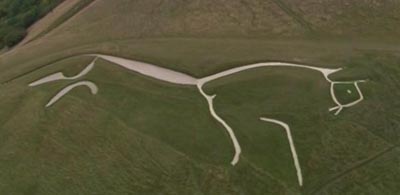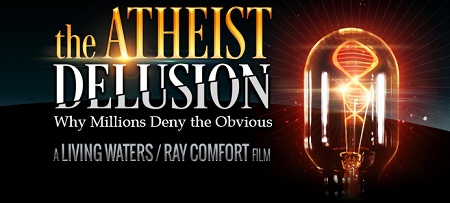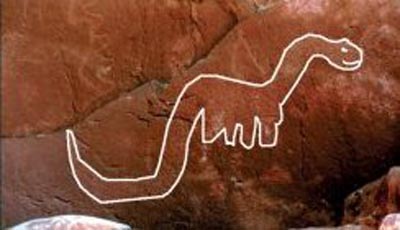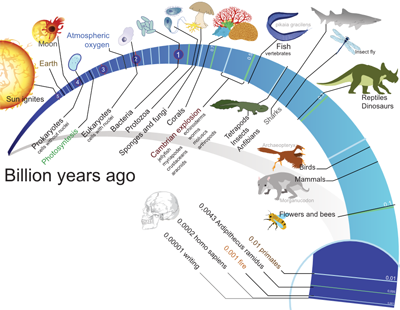In his latest evangelistic movie “The Atheist Delusion – Why Millions Deny the Obvious” Ray Comfort is once again out among atheists in what I’d like to say is his inimitable style – but that would be a very inaccurate description. Because it is clear that Comfort has developed an easy to use approach that he’d like every Christian to use when confronted with atheist claims of “there’s no evidence of God”. Continue Reading
Category Archives: Atheism
What is Religion? Does evolution qualify? Atheism?
 |
Atheists and evolutionists claim they have no religion. But is that true? |
| A Torah scroll containing the first five books of the Bible Text highlighted: The first words of Deuteronomy 6.5 |
Atheists are fond of saying that they have no religion, because atheism is not a religion. Here’s an example from Twitter.
Likewise, evolutionists claim that evolution is science, a fact, and certainly not religion. Here, for example, is a video of Richard Dawkins at big think claiming evolution is a fact. But are atheists and evolutionists correct in asserting that their respective beliefs are not religions? That of course depends on the definitions.
Evolutionists are notorious for redefining evolution to suit their needs for the occasion. In other words to keep evolution from being exposed as the total fraud it is, they keep changing the meaning of the word “evolution”; so they wind up claiming you’re not speaking about the same thing; though you’re speaking of the same evolution the discussion started with. For instance, you may start out with a statement like “molecules to man evolution has never been observed.” They’ll return something like, “Do you know what evolution is? It’s a change in the allele frequency of a gene pool.” These are two different things; two different discussions, and thus you can never convince them of anything. Steven Meyer and Mike Keas have documented 6 of the common uses of the term “evolution” that evolutionists switch between.1 There’s a term for that tactic. It’s the logical fallacy known as equivocation.
Therefore to say there is no God is arrogant), and thus they simply say “I don’t know if God exists” – the agnostic position.
And with Bill O’Reilly out there confusing people with his repeated claims that Christianity is a “philosophy” not a religion,2 Christianity is not without those who are muddying the waters. So can we claim any of these are religions? Yes, these are all religions and that can be clearly seen once we understand the difference between how a religion is recognized, and how it is expressed by adherents.
Religion and the Establishment Clause
The courts have been a favored weapon of atheists and to a lesser degree evolutionists in the battle to silence Christians while simultaneously getting their Godless theories to be accepted and promoted in government sponsored venues like schools. The typical approach is to use the first amendment’s “establishment clause” against anything that even sounds Christian.
The Establishment Clause of the First Amendment to the Constitution of the United States:
The clause reads as follows: Continue Reading
The Problem of Evil – proof that God exists
 The Fall of Lucifer Antonio María Esquivel y Suárez de Urbina, 1840 |
Paradoxically, the problem of evil is proof that God exists. |
On Friday, December 14th, 2012 a gunman who shall remain unnamed so as to deny him any further fame, entered the Sandy Hook Elementary School in Newton Connecticut, and shot and killed 20 students and 6 adults. Before driving to the school for the rampage he had killed his mother, and when finally confronted, he killed himself bringing the death toll to 28. In a news conference that same day, Gov. Dannel Malloy summed it up succinctly: “Evil visited this community today”.
This article is being written, as it turns out, on the 20th anniversary1 of the Oklahoma City Bombing on the Alfred P. Murrah Federal Building which killed 168 people and caused 680 nonfatal injuries. Additionally it caused an estimated $652 million in damages.
These are but a couple of drops in a sea of evil that in one way or another touches the lives of every single human being that lives and has ever lived. This curse upon humanity is paradoxically an affirmation of the truth of God for Christians, while for those unwilling to believe, it becomes a reason (in their mind) why they shouldn’t believe God exists. Why is it that people can look at the same evidence and come to diametrically opposed conclusions? How can consideration of a single issue – in this case the existence of evil – result in such radically different reactions and beliefs from people? One might ask the same questions of a phenomenon at the other extreme of the moral continuum – miracles.
 Why do miracles cause some to believe, while others only see in them only something to either scoff at or be angry at; or to make accusations that people are being “misled”? In both cases (reactions to the problem of evil and the reaction to miracles) the root cause is the same: an unwillingness to acknowledge God as Lord who will bring all created things under his control and under his judgment.
Why do miracles cause some to believe, while others only see in them only something to either scoff at or be angry at; or to make accusations that people are being “misled”? In both cases (reactions to the problem of evil and the reaction to miracles) the root cause is the same: an unwillingness to acknowledge God as Lord who will bring all created things under his control and under his judgment.
The mere thought of God as Lord manifests itself for many as statements of unbelief. As particles in the atmosphere are the core around which moisture coalesces to form rain drops or snow, likewise miracles and the problem of evil are items around which unbelief can coalesce and be visibly expressed.
For those living in disobedience the prospect of a God who will judge all is a scary one. And their unwillingness to face this truth is not because of their ignorance of God – no God has made his existence plain to all (Rom 1.19). No, it’s not ignorance of God that’s the problem, it’s an unwillingness to be subject to God that causes them to express views inconsistent with their worldview, and thus speak as a hypocrite or express irrational view (or both) as we’ll see. Continue Reading
Does ancient art prove dinosaurs lived with humans?
Does Ancient Art Prove Dinosaurs lived with Humans? |
Evolutionists and materialist scientists believe that dinosaurs were killed off in a mass extinction event – an asteroid striking the earth – that happened (so they say) 65 million years ago. (A time frame based on circular reasoning. See GULO and Other Irrational Atheist Arguments, Part 2.) They also believe that man did not evolve to the current, recognizable form of homo sapiens until 200,000 years ago. Thus according to their timeline, it is impossible for dinosaurs and man to have lived together because dinosaurs went extinct some 64.8 million years before the first human existed. This gap is depicted in the evolutionary diagram1 below: (Between the green dinosaur and the white human skull.)
What then are we to make of all the depictions of dinosaurs in ancient art, as the one above of the brontosaurus? To see a good number of these depictions, visit Genesis Park Ancient Dinosaur Depictions.2 One of my favorites is this one from a temple in Angkor, Cambodia:

The implication from such art – humans saw living dinosaurs – invalidates the evolutionary timeline above. It also questions the validity of the entire evolutionary story. So evolutionists and materialists object strongly to the conclusion that such art depicts what it appears to: dinosaurs living in full view of humans who saw them and captured them in art. Since dinosaurs living with man is denied by evolutionists, atheists and others, they must come up with an explanation of how these depictions came about. Time now for evolutionist story-time, because as we’ll see none of their explanations make sense and are fit only for young children who don’t know better, and the gullible. Let’s run down the common explanations for the stegosaurus carving above:
Objection: “It doesn’t look like a stegosaurus”
This is a common objection on the ‘net regarding the Angkor stegosaurus depiction. I would then ask what is this next picture a depiction of?

Here’s a description:
“Carved into the white chalk hills of southern England is a giant figure. This astonishingly graphic outline is said by some to go back 3000 years. Other theories date it to King Alfred’s victory over the Danes 1200 years ago. What is it? Who carved it into this chalk hillside and why? It looks like a horse but legend tells us it may be the dragon slain by St. George, patron saint of England.”3
What do you think it is? Continue Reading
The Waning, Great Scientific Hope
|
With a new year comes renewed hope in many endeavors. 2015 is no different. Among materialist scientists (those adhering to philosophical materialism – thus rejecting anything exists beyond the material world), hopes are high that researchers will find an earth like “exoplanet” – a planet that orbits a sun other than our own. As space.com’s Mike Wall1 reports:
The excitement is heightened as researchers prepare to launch a sun shade – a man made device to eclipse a star in front of a remote telescope like Kepler in the next decade – allowing it, and them, to see faint planets that would otherwise be invisible due to the glare coming from the star. But why the excitement? And why the insatiable desire to find earth like planets? Simply put, scientists are rushing head long to find the Great Scientific Hope. The Great Scientific Hope For materialist scientists, there is no greater hope than Continue Reading |
Is Faith Rational?
1. How can faith be rational, when faith means believing in something with no evidence? Or: 2. Is Faith/belief in God/belief in miracles compatible with science?
Starting with the second question – Faith in God and belief in miracles are compatible with science because faith and science are complimentary; not contradictory. There are questions that science is not equipped to handle. In such cases it doesn’t mean the item the question isn’t real; it simply means that science is incapable of answering the question. One such item, as author, scientist and theologian Alistair McGrath points out is this:
The answer clearly is no, science can’t answer it. And why not? Famous evolutionary biologist and historian of science Stephen Jay Gould suggests it’s because science and religion deal with different spheres of knowledge – “magisteria” as he called them – and they do not overlap. Science and religion are thus Non-Overlapping Magisteria (NOMA)[2] – so the one can not comment on the other. This formulation is close. Science can not see or measure the spiritual world, so it can not comment on it; but God, who is spirit (John 4.24) sees both the spiritual and material world, and thus can comment on both as an eye witness. Thus regarding the creation of the world, what you have in Genesis 1 is an eye witness account of the creation of the heavens and the earth in 6 days, and recorded as evidence – a testimony for all time. In passing, God as an eye witness to the creation is something science can not disprove. They can disagree with his testimony, (which they do) and disbelieve he even exists (which they do), but they can not prove he does not exist. Neither can they provide an eye witness to their version of creation – the big bang. They say believing God’s testimony can only be done by faith. Okay, so what is it when you believe George Washington was the first president? No one alive today was there to see it. All we have are testimonies. Is that not then, also faith? Yet no one asks scientists to prove George Washington was the first president, or prove that he existed. They take both to be true on the word of historians. Biblical testimony is no different. So why is faith in God’s written testimony any less rational than believing written testimonies that George Washington was the first president? If doubters of the Biblical account still want “proof” one can say creationists have higher quality “proof” than scientists – since in addition to scientific evidence, creationists have an eye witness account by a perfect witness while science merely has a of highly disputed theory – the big bang[3] which is backed by highly disputed evidence. Indeed the more we learn, the more the big bang is discredited. The universe is both too young for the theory to be true (for more on that see Saturn’s Rings are Young!) and recent discoveries like the Higgs Boson (the so called “god particle”) contradict the Big Bang theory. (For more on that see Testimony of the Higgs Boson.) So faith expressed as belief that God exists is rational; it is consistent with how we use “faith” in other spheres, and it is consistent with science. But some people don’t agree with that assessment for reasons that take us back to the first question: “How can faith be rational?” (implied: when science can’t see the evidence to prove it). This is perpetuated by a chorus of acolytes echoing the refrain:
What’s always amusing about these statements is the claim there is no evidence. Because the first thing they typically do is list the evidences then explain why they refuse to believe it. First off they want to eliminate the Bible as evidence because it’s well – the bible – a holy book. They never seem to realize they are committing the fallacy of a false analogy when they compare the Bible to a book of mythology or even other holy books. Unlike mythology and other “holy” books the Bible is full of verified history, fulfilled prophecy (we’ll note one below), known, verified historical people, and geographical locations that exist to this day that you can visit. That makes it a reliable source of information. In fact regarding reliability of the key section of the Bible that records the life, death and resurrection of Jesus – the New Testament – author and apologist Josh McDowell states:
|
||||||
Physical Evidence Jesus Existed
 Interior – St. Peter’s Basilica as painted by Giovanni Paolo Panini Interior – St. Peter’s Basilica as painted by Giovanni Paolo Panini |
Claims that there is no evidence that Jesus ever existed are simply untrue. Here’s why. |
In the companion article, Is Faith Rational, I note that many atheists claim:
You’ll find this objection from bloggers and authors2 alike among other skeptics. In response, I pointed out 4 items that are historical or archaeological evidence of the existence of Jesus to silence this claim. They are:
In the companion article there was not space to discuss these issues, so here is that discussion. Physical Evidences of Jesus’ Existence: First, please note these are presented as evidences not proofs. It’s very difficult to “prove” anything that happened in the past. However what we do have left from events in the past is evidences that the event occurred. The following are evidences that Jesus existed. 1. St Peter’s Basilica; Cathedrals and Churches all over the world. Before moving on – wait – I hear an atheist saying, based on that logic every pagan god for which a temple was built must also exist. Nice try. Let’s consider a pagan temple the Bible mentions – the temple of Artemis (Roman name: Diana) in the city of Ephesus. (Acts 19.27) and compare how people treat a mythical god with how they treat Jesus: – Is Artemis worshipped in any significant way today? Does she have thousands of temples/churches? – When swearing or cursing, does anyone swear by Artemis? Or use Artemis as an expletive? – Does anyone claim Artemis loved mankind enough to become incarnate, live on earth and redeem mankind from his own sin and folly? – Is time divided before and after the coming of Artemis? – Does Artemis have an animal marked on its body with her symbol that carried her in triumph as Jesus does? (John 12.12-15) Has her symbol inspired kings and armies like the Chi Rho did Constantine and his army? – Did Artemis prophesy anything that was fulfilled? Whether you love Jesus and revere him or despise him and use his name as an expletive, clearly the responses to Jesus has always been, and always will be qualitatively and quantitatively different from any other so called god. This makes both the worship of Jesus and his places of worship also qualitatively different. There is an entire fabric of evidences that St Peter’s Basilica becomes part of strengthening the entire case for the existence of Jesus. The temple of Artemis [or substitute any false god – Zeus, whatever] is a single thread that simply reminds man of his tendency to idolatry and folly. So please, don’t bother with the comparisons to other fallen temples. 2. Nails From the the Cross of Jesus While this find is helpful, what’s even more interesting is this: archeologist Simcha Jacobovici, noted that in the grave of the Caiaphas were two nails. He believes he has found the very nails used to affix Jesus to the cross, stating he has made: Continue Reading |
Atheists – Willfully Ignorant in their Looking Glass World
|
||||||
In the Looking Glass world of Alice in Wonderland, Tweedledee’s “logic” makes perfect sense. In the real world – it’s nonsense – or to be more precise – suffers from both a formal and a non-formal logical fallacy.2 Yet it makes perfect sense to Tweedledee and Tweedledum. In the same manner, the logic of atheists makes perfect sense to them in their looking glass world where they protect themselves from the truth; they can’t see anything wrong with it – yet it is clear to others it is as fallacious as the flawed logic of Tweedledee and Tweedledum. When difficult questions are put to atheists about the nature of reality for which the atheistic worldview has no answer, atheists (and evolutionists alike) throw out fine sounding arguments. And like the Looking Glass characters, their answers have the form of validity, but upon close examination it is apparent their arguments are as fallacious as the logic used by the Tweedles. Let me give a couple of examples. Consider the question – Why is there something rather than nothing? For the Christian, there’s an easy answer: In the beginning, God created the heavens and the earth (Gen 1.1). For philosophers, it is a very deep philosophical question. In fact Martin Rees, cosmologist, astrophysicist and astronomer royal calls it the “preeminent mystery.”3 Such a formulation does not affirm the Christian worldview, but neither is it overtly antagonistic. But for particle physicist, skeptic (of the supernatural) and atheist Victor Stenger that question is:
|
||||||
GULO and other Irrational Atheist Arguments – Part 2
7 Popular, but Fallacious Arguments by Atheists
 Evolution uses circular arguments to support the supposition that dinosaurs became extinct 65 million years ago. Evolution uses circular arguments to support the supposition that dinosaurs became extinct 65 million years ago. |
More arguments used by atheists that upon inspection are clearly wrong and fail to support atheistic or evolutionary doctrine. |
|||
| In Part 1 of this article I discussed problems 1 and 2: GULO and LUCA respectively and why they are irrational arguments. In closing the discussion on LUCA I noted that evolutionists and atheists are blind to evidence of intelligent design. This leads into our next irrational argument: 3. “There’s no evidence”Atheists and Evolutionists alike tend to use this argument for anything they don’t believe. They don’t believe in God, so they say there’s no evidence of God. They don’t believe in intelligent design, so they say there’s no evidence for it. They don’t believe in miracles, so they say there’s no evidence of them. This argument is particularly common in the twitter world: 
Notice the above person states no “verifiable” evidence. This means there is no evidence you can present that will meet his standard for “verifiable.” (An illicit shifting of the burden of proof.) The problem with saying “there’s no evidence” is you must then explain away all the sites with evidence – like this one, or creation.com or answersingenesis.org or a host of other sites and books (including the Bible) which provide the evidence against evolution and for God and intelligent design which they claim doesn’t exist. Brian Auten provides a list of such sites on his Apologetics315 here. In light of the overwhelming evidence, one is tempted to say they’re simply lying. After all, it’s one thing to say the evidence is misunderstood; quite another to say that none exists. But there are at least two other dynamics likely at play here.
Part of the light of the gospel is the fact that God exists and God created. The god of this age – Satan – doesn’t want you to believe that; so those following atheistic or evolutionary beliefs have unwittingly fallen for yet another lie of the father of the lies, which keeps them captive to false philosophies. We must pray for such people in hopes that “they will come to their senses and escape from the trap of the devil, who has taken them captive to do his will.” (2 Tim 2.26)
4. “Dinosaur fossils are millions of years old “Everyone knows what wiped out the dinosaurs. Sixty five million years ago it came from outer space.”1 So begins a documentary entitled “What really killed the dinosaurs?” It perpetuates the supposed date which scientists have settled on as the date for when the dinosaurs became extinct: 65 million years ago. Scientists also use fossils to verify that date – a date which supports an old earth theory of earth history instead of a young one. But as Kent Hovind is fond of pointing out the fossil evidence argument is a circular one. He relates the story of a visit he took with his daughter to the School of Mines & Technology Museum of Geology, Rapid City S.D. His daughter asks the tour guide” Continue Reading |
||||
GULO and other Irrational Atheist Arguments – Part 1
7 Popular, but Fallacious Arguments used by Atheists
For those wondering why the apostle cast out a demon providing free advertisement for him, the answer is simple: God’s people are forbidden from having anything to do with demons2 – even if what they do is initially helpful. The amazing thing to Christians is that Paul put up so long with it. I mention it because I likewise feel troubled by the recurring contention of Atheists that the pseudo-gene known as GULO or GLO proves common descent. So let me
1. “GULO proves Evolution” What is GULO and how does it supposedly prove evolution?
L-gulonolactone oxidase – commonly known as GULO – is a gene designed to synthesize vitamin C from glucose or galactose, but in some groups of animals, the GULO gene does function in that manner, and so it is given the label of “pseudogene.”4 Additionally, the gene is “broken” reportedly in the same place in multiple species resulting in a loss of the ability to synthesize vitamin C. Humans are not able to synthesize vitamin C. Neither are guinea pigs, chimpanzees and several species of monkeys along with some species of birds, bats and fish. Evolutionists look at these facts and conclude that the only way the gene could have broken in the sample place is if the gene of a common ancestor became broken, and that same broken gene was then inherited by subsequent descendants. Thus to their way of thinking the only way this broken gene would show up in multiple species is if it started in a common ancestor. Recent evidence refutes this conclusion, and the attempts by evolutionists to salvage their conclusion makes matters worse – Continue Reading |
||||||








